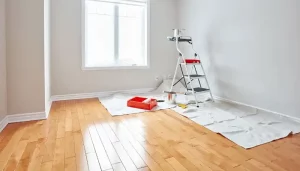The urge to personalize and improve your living space is a natural human desire. In today’s world, tackling these projects yourself, often referred to as DIY (Do-It-Yourself) home improvement, has become increasingly popular.
But before you grab your toolbox and dive headfirst into renovations, it’s crucial to weigh the pros and cons. This guide will equip you with the knowledge to make an informed decision about whether DIY is the right approach for your next home improvement project.

The Rise of DIY Home Improvement
DIY projects have exploded in popularity in recent years. This can be attributed to several factors:
- Accessibility of Information: The internet is a treasure trove of DIY tutorials, guides, and online communities. With a few clicks, you can find detailed instructions for nearly any project imaginable.
- Home Improvement Shows: Popular television programs showcase DIY transformations, inspiring viewers to tackle projects themselves.
- Cost-Effectiveness: In an era of rising costs, the potential to save money by doing things yourself is a significant motivator.
The Cost-Effectiveness Debate
One of the biggest arguments for DIY is the potential to save money. However, this isn’t always a straightforward calculation. Here’s a breakdown of the cost factors to consider:
Pros:
- Elimination of Labor Costs: Hiring a contractor can significantly inflate the overall project cost. By doing the work yourself, you eliminate these labor charges.
- Finding Budget-Friendly Materials: With careful planning and research, you can often find deals on materials by shopping around at discount stores or utilizing salvaged materials.
Cons:
- Costly Mistakes: DIY projects come with the risk of mistakes. Fixing errors, especially in plumbing or electrical work, can be expensive and require professional intervention.
- Hidden Costs: Factor in the cost of tools and equipment you might need to purchase or rent for the project. Additionally, unexpected complications can lead to additional material purchases.
The Rewards of DIY: Beyond the Bottom Line
While cost savings are a major consideration, the benefits of DIY extend beyond the financial.
- Sense of Accomplishment and Satisfaction: Completing a DIY project yourself brings immense satisfaction. Seeing your vision come to life through your own efforts is a rewarding experience.
- Building Skills and Knowledge: DIY projects provide an excellent opportunity to learn new skills and broaden your knowledge base. You’ll not only gain practical experience in construction techniques but also develop valuable problem-solving skills.
The Pitfalls of DIY: When to Call in the Professionals
While DIY can be empowering and rewarding, it’s important to be realistic about your skillset and the complexity of the project. Here’s when it might be wiser to seek professional help:
- Risk of Mistakes and Errors: Some projects, like electrical wiring or structural modifications, require expertise and proper permits. Mistakes in these areas can be dangerous and costly to rectify.
- Time-Consuming Corrections: Underestimating the time commitment of a project can lead to frustration and delays. Professionals can complete tasks efficiently, minimizing disruptions to your daily life.
Lack of Expertise and Specialized Tools:
Certain projects necessitate specialized skills and tools that may not be readily available to the average homeowner.
- Importance of Professional Skills: Complex projects like plumbing or roof repairs require a deep understanding of building codes and safety protocols. Hiring a qualified professional ensures the work is done correctly and adheres to regulations.
- Cost of Acquiring or Renting Tools: Some projects necessitate specialized tools that can be expensive to purchase. Renting them may be an option, but ongoing rental fees can add to the overall project cost.
The Verdict: DIY or Not to DIY?
Ultimately, the decision to DIY your home improvement project depends on your individual circumstances. Here are some key questions to ask yourself:
- Skill Level: Be honest about your DIY experience and comfort level with the tasks involved.
- Project Complexity: Research the project thoroughly to understand the scope of work and any potential challenges.
- Time Commitment: Can you realistically dedicate the time needed to complete the project on schedule?
- Budget Flexibility: Factor in the potential costs of materials, tools, and potential mistakes when budgeting for your project.
DIY Done Right: Mastering Cost-Effectiveness in Home Improvement Projects
The satisfaction of transforming your living space with your own two hands is undeniable. But let’s face it, home improvement projects can quickly turn into budget-busters. The key to a successful DIY project lies in cost-effectiveness, where the value you create outweighs the money spent. This article equips you with the knowledge to navigate the world of DIY home improvement and make financially savvy decisions.
Understanding the Cost Equation: Project Type and Scale
Not all DIY projects are created equal. Here’s a breakdown of how project characteristics influence cost-effectiveness:
Simple Repairs vs. Complex Renovations:
- Simple Repairs: Think replacing a leaky faucet, caulking a bathtub, or painting a room. These tasks typically require minimal tools and readily available materials, making them perfect for DIY beginners.
- Complex Renovations: Major projects like rewiring an electrical system, installing a new roof, or gutting a bathroom require specialized skills and permits. While the allure of a complete overhaul might be tempting, tackling such projects without proper expertise can lead to costly mistakes and safety hazards.
Assessing Your Capabilities and Limitations:
- Be Honest About Your Skills: Don’t underestimate the importance of plumbing know-how when replacing a toilet, or carpentry skills when building a deck. Overestimating your abilities can lead to wasted materials, damaged property, and the need to hire a professional to fix your mistakes.
- Learn and Grow: There’s a wealth of online tutorials, workshops, and home improvement resources available. Utilize these to build your skillset and tackle progressively more complex projects over time.
The Time Investment: Balancing Hustle with Life
While DIY saves money on labor, it requires a significant time investment. Here’s how to factor in the time element:
- Balancing DIY with Personal Commitments: Be realistic about the time you can dedicate to a project. Rushing through tasks to meet an arbitrary deadline can lead to shoddy work and potential safety risks. Factor in work schedules, family obligations, and other commitments to ensure you can complete the project at a steady pace.
- Opportunity Cost: Consider the value of your time. Could those hours spent DIYing be used to earn additional income that could pay for a professional to complete the project? Weigh this opportunity cost when making your decision.
Maximizing Cost-Effectiveness: Your DIY Toolbox
Now that you understand the cost factors at play, let’s explore strategies to maximize cost-effectiveness:
- Research and Planning:
- Gather Information: Before diving in, thoroughly research your project. Understand the steps involved, the tools and materials required, and potential pitfalls. Utilize online resources, consult experts at hardware stores, and don’t be afraid to ask experienced DIYers for advice.
- Budgeting and Timelining: Create a detailed budget that includes materials, tools (consider renting if it’s a one-time use), and any potential waste disposal fees. Develop a realistic timeline that factors in your available time and the complexity of the project.
- Start Small & Build Confidence:
- Manageable Projects: Begin with smaller, easily achievable tasks like painting a room, replacing cabinet hardware, or installing shelves. These projects allow you to build practical skills and gain confidence in your abilities.
- Knowing When to Call in the Pros: There’s no shame in recognizing your limitations. If a project seems beyond your skillset or requires permits or inspections, don’t hesitate to seek professional help.
Conclusion
This article has explored the critical factors that influence cost-effectiveness in DIY home improvement. Remember, the decision to DIY revolves around finding the sweet spot between your skills, time constraints, budget, and the project’s complexity. Weigh the pros and cons carefully, leverage available resources, and make informed decisions to turn your DIY dreams into rewarding and budget-friendly home improvements.


